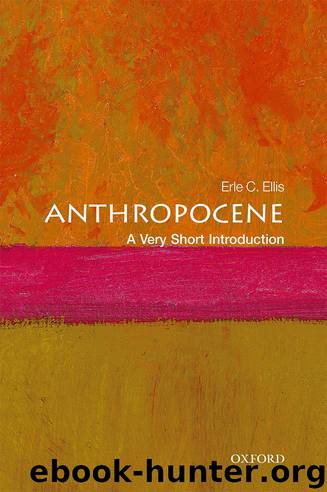Anthropocene by Erle C. Ellis

Author:Erle C. Ellis
Language: eng
Format: epub
Publisher: Oxford University Press
Published: 2018-01-15T05:00:00+00:00
27. A timeline of early agricultural development illustrating the diversity of pathways to agriculture in different regions at different times.
Agricultural populations grew more rapidly than those of hunter-gatherers and ultimately displaced them across Earth’s most productive lands both directly and when hunter-gatherers adopted agricultural practices themselves. The social and environmental changes brought by agriculture were far from linear over time. Countless societies collapsed and began anew. Still, there is a clear long-term trend towards ever-larger scales of agrarian societies supported by increasingly productive land use practices, or ‘land use intensification’, over time. Early practices of shifting cultivation used land for a year or two and then cleared more once soil fertility declined. Agrarian populations, resource demands, and social and cultural capacities grew and developed, and more labour- and energy-intensive techniques were adopted to increase the productivity of land, including the planting of crops every year, irrigation, manuring, the plough, and other methods. Agricultural intensification using manures began in Southwest Asia and Europe as early as 8,000 years ago, based on stable nitrogen isotope ratios in preserved grains, and irrigated rice production is in evidence as early as 7,000 years ago in China and India, becoming widely established in key rice growing regions by about 5,000 years ago.
Abundant evidence confirms that agricultural land use was widespread by the mid-Holocene, including deposits of soils and sediments caused by increased soil erosion, charcoal, the remains of crop plants and weeds, including pollen, starch grains, and phytoliths (silica crystals produced in plant cells), the bones and other remains of domestic livestock, changes in the isotopic composition of soils and fossil manures, and long-term changes in vegetation structure and species composition left behind after early land clearing and soil tillage; present-day woodlands from the Mediterranean to the Tropics are increasingly recognized as the bio-cultural legacies of long histories of prior human use. Agricultural land use also produced anthropogenic soils, from the manure-enriched ‘plaggen’ soils of north-western Europe, which may date to 4000 bc, to the ‘terra preta’, or ‘dark earth’ soils enriched with charcoal and waste materials that are observed across the Amazon basin dating perhaps to 500 bc and may also have been produced in Africa, together with various ‘anthrosols’ altered by manuring, tillage, irrigation, and other land use practices in different regions. The widespread presence of anthropogenic soils has been suggested as a golden spike for the Anthropocene, circa 2,000 years ago, though the prospects for a successful GSSP proposal based on anthropogenic soils are not strong, owing to their diachronous origins.
Agricultural transformation of Earth began more than 10,000 years ago and continues to convert natural habitats to agricultural landscapes engineered and managed to support populations of domesticated species (Figure 28). Spreading gradually across the continents over millennia, agriculture began leaving a legacy of altered soil chemistry and sedimentary processes transformed by land clearing, soil tillage, and erosion. Hydrology was altered by reservoirs and irrigation systems. And the functioning of the biosphere, the atmosphere, and the Earth system as a whole began to change.
Download
This site does not store any files on its server. We only index and link to content provided by other sites. Please contact the content providers to delete copyright contents if any and email us, we'll remove relevant links or contents immediately.
Man-made Catastrophes and Risk Information Concealment by Dmitry Chernov & Didier Sornette(5647)
The Revenge of Geography: What the Map Tells Us About Coming Conflicts and the Battle Against Fate by Kaplan Robert D(3961)
Zero Waste Home by Bea Johnson(3655)
In a Sunburned Country by Bill Bryson(3364)
COSMOS by Carl Sagan(3346)
Good by S. Walden(3345)
The Fate of Rome: Climate, Disease, and the End of an Empire (The Princeton History of the Ancient World) by Kyle Harper(2870)
Camino Island by John Grisham(2718)
A Wilder Time by William E. Glassley(2689)
Organic Mushroom Farming and Mycoremediation by Tradd Cotter(2565)
The Ogre by Doug Scott(2501)
Human Dynamics Research in Smart and Connected Communities by Shih-Lung Shaw & Daniel Sui(2431)
Energy Myths and Realities by Vaclav Smil(2380)
The Traveler's Gift by Andy Andrews(2298)
9781803241661-PYTHON FOR ARCGIS PRO by Unknown(2268)
Inside the Middle East by Avi Melamed(2230)
Birds of New Guinea by Pratt Thane K.; Beehler Bruce M.; Anderton John C(2175)
A History of Warfare by John Keegan(2104)
Ultimate Navigation Manual by Lyle Brotherton(2048)
